As our ferry cut through the early summer fog, St. Pierre played hide-and-seek: one moment the island’s brightly painted buildings stood out in vivid color against the gray Atlantic, and the next, it all vanished like a mirage into the cool Grand Banks mist.
For my husband, Evan, and I, the idea of visiting this tiny French island of eight islands just 12 miles off the south coast of Newfoundland came to me a few weeks ago while listening to Newfoundland’s Great Big Sea’s “French Perfume.” As we were getting into the mood for our upcoming road trip to Newfoundland and Labrador, the lyrics alluding to St. Pierre and Miquelon’s smuggler past had me immediately Googling it.
I was fascinated by the photos of the windswept, mysterious archipelago, and what I read piqued my curiosity even more. Saint-Pierre and Miquelon (as locals call it) boasts just 6,000 inhabitants and a mix of Basque, British, Canadian and, of course, French influences. But what really impressed me was the relatively recent investment of CAD 55 million by France and the Newfoundland and Labrador government. They’re keen to promote tourism between the destinations through two ferries (which, after six years of hard work, are finally fully operational in 2021), and I was happy to change my itinerary to international.
After checking the ferry schedule, we booked a room at the family-run Auberge Quatre Temps (be sure to book in advance of the ferry, as accommodations can fill up). The ferry, which can accommodate 188 passengers and 15 cars, departs eight times a week from a small town called Fortune on Newfoundland’s Buren Peninsula. After checking in, we simply walked onto the boat. Cars are only recently allowed in this part of France, and like many other passengers, we didn’t realize we had the option to bring our car until it was too late.
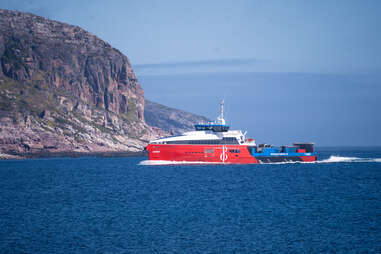
After settling into our comfortable cabins, several fellow passengers on the 90-minute journey told us they too were traveling to Saint-Pierre on a whim.
“We were at a restaurant looking at a map of Newfoundland and noticed there was an international border just off the coast,” one woman explained. Curious, she asked around. “We wanted to go to France for the Olympics, so here we are,” she added, gesturing to her family.
Despite a quick Google search, my knowledge of the last vestiges of France’s once-vast North American empire was fairly limited as I set out on my European-style detour. Here’s what I did know: A strange combination of geography and law (as a French territory, the SPM was not subject to U.S. regulation) meant the archipelago was a major supplier of liquor during Prohibition. In just a few years, it went from being a remote fishing colony to a hub of a criminal trade that created moonshiners, rum traffickers, and millionaires.
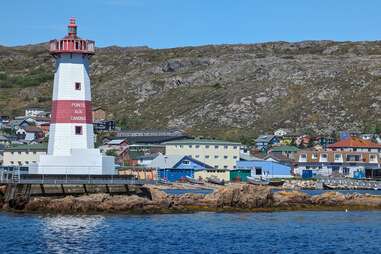
Though closer to puffins and icebergs than its American hideaways, Saint-Pierre and Miquelon was once bustling with businessmen, smugglers, and gangsters in the 1920s, according to tour guide Hélèa de Urbain. As she led us along hilly roads lined with little Peugeots and Citroëns (and a big Ford truck, conspicuous for its size and unusual South Carolina license plate), the college student, home for the summer, explained how this sleepy Basque fishing port, once a battleground between France and Britain, had come to have an unlikely influence on American culture.
Prohibition also transformed the small town’s architecture in the form of storage warehouses, banks, and office buildings. The French government at the time spent millions of dollars renovating the port and had entire buildings shipped across the Atlantic to be reassembled here. Even with the new infrastructure, there was still not enough space to store so much alcohol. Elea explains that businesses were forced to rent people’s basements, where they stored millions of bottles of liquor, pointing out a particularly sturdy-looking basement door in one home.
Unlike the inferior homemade liquor that circulated in Prohibition-era America, the liquor sold at SPM was the finest. “The gangsters were serious about quality,” Ellea said. This commitment to product even gave rise to a new adage: Any liquor smuggled by the infamous Bill McCoy, who smuggled rum, gin, and French wine from SPM’s ports up to the “Rum Line,” or the U.S. three-mile limit, was guaranteed to be of the highest quality. Thus, the word “genuine” was born.
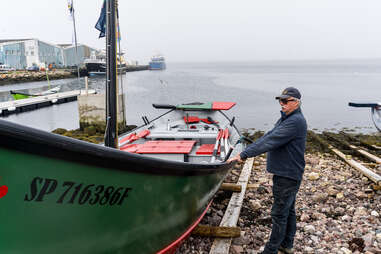
After a morning steeped in history, we were ready to indulge in some local cuisine. Saint-Pierre’s compact town centre is clustered around a protected harbour and is easy to get around on foot. After walking past a few shops that were already closed for lunch, we stopped into unassuming Le Feu De Braise for a hearty meal of fresh lobster and mussels that wouldn’t be out of place on the Brittany coast.
We then walked back to the water’s edge to a row of brightly painted fishing huts, where we met Gérard Hélène, president of Les Zigotos, a local group dedicated to preserving the Saint-Pierre working dories, flat-bottomed wooden fishing boats once seen throughout the archipelago.
Gerard, a descendant of SPM’s original dory builders, is passionate about preserving this ancient history of SPM. Soon he and his boating husband were leaning against the crayon-colored hulls, mouthing words like “sear” and “rocker.” I was content to leave them to it as we wandered the club’s small museum, admiring photos and artifacts commemorating the cod fishing’s heyday. The smell of salt and old wood permeates the room, evoking a time when these dories were essential to island life.
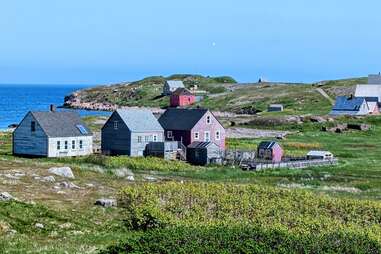
To dig deeper into SPM’s roots, the next morning we boarded a converted fishing boat, “Le Petit Gravier,” and took a water taxi across the harbor to the uninhabited Île aux Marins (Sailors’ Island) at 10:30 a.m. At first I wondered if I’d got the time wrong: SPM operates in its own time zone, 30 minutes ahead of Newfoundland, but my phone randomly switches between Canadian and French carriers depending on where I’m standing, so I was always unsure whether I was late or early.
The arrival of Elea (who seemed to be our guide throughout it all) and some familiar faces from the ferry reassured us that we had arrived on time. Soon we were wandering the grassy island, learning about island life as we passed a church (Notre-Dame des Marins), fishermen’s houses, a bustling school, and children lined up endless rows of cod to dry on the island’s vast gravel floor. We also got a glimpse of the island’s French influence when we encountered locals carrying picnic supplies: brie, foie gras, and freshly baked baguettes. Elea explained that Île aux Marins is not only an open-air museum, but also a popular spot to escape the hustle and bustle of everyday life on a sunny day. The tiny island also hosts summer camps for kids and soccer clinics.
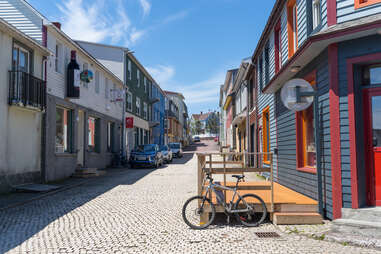
Most of the SPM residents speak English, but we used the French we learned in high school to help read menus, help ferry passengers find liquor stores, etc. This woman is the one who booked the trip for her family as soon as she noticed the border, but didn’t realize that it’s still not common to bring cars onto the island, and when she called the SPM ferry office to book, a car was automatically booked for her as well (cars cannot be booked online through their website, only over the phone).
She told me that having a car made her stay even more adventurous. She drove far into the island in search of French wine, but so far all she found were fresh pastries, a bookstore, plenty of horses that are descendants of the horses used for transportation back in the day, and some great lookout points. To save her some driving, I took her to the nearby Boucherie Epicerie Chez Julien, which also had a great selection of local pates. She shared some highlights of her road trip, including a hike she took at the northern end of Saint-Pierre.
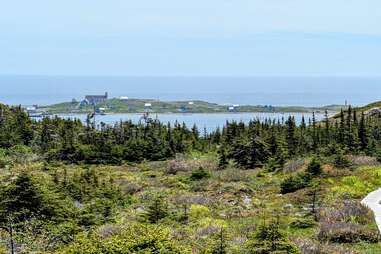
A local picked us up and we were soon out of town, at the trailhead for L’Anse-à-Henry. The treeless, rugged, and dotted with small ponds made me feel like I was back in time to Newfoundland. Newfoundland was on the horizon. Soon we were in the middle of the island, where there was only the smell of the sea and the ocean mixed with northern plants like fragrant sweet gale and refreshing Labrador tea. As we reached the other side of the island, thousands of petrels and puffins flew off from nearby Grand Colombier, and the air was filled with the calls of seabirds. In the distance we could see a small boat. It was easy to imagine an old Basque fisherman rowing his dory back from his fishing grounds, or a smuggler coming in to pick up another load of rum, or a tour guide steering his boat to show tourists the wildlife. Slowly the mist rolled in, the boat disappeared completely, and my fantasy came to an end.
The next day we took the ferry back to Newfoundland. Standing on the aft deck, I exchanged views with some of the passengers I’d passed so many times in this tiny French enclave, and we all agreed that we needed to go back. One of them pointed out that the striped lighthouse of Saint-Pierre was still visible, and then, as the fog thickened and engulfed both lighthouse and mysterious little island, he gasped. “It’s like it was never there to begin with!”
Want more Thrillist? Follow us Instagram, TikTok, Twitter, Facebook, Pinterestand YouTube.
#Americans #drive #France